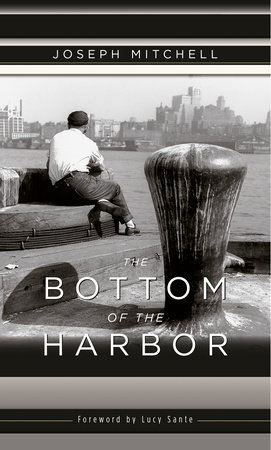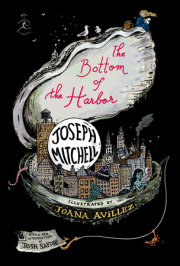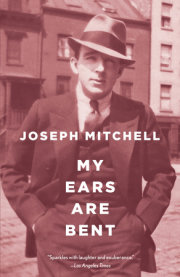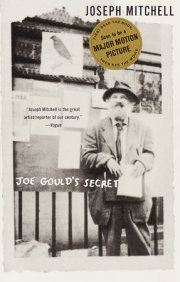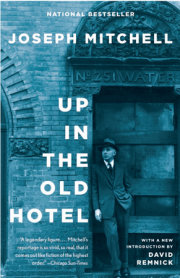Up in the Old HotelEvery now and then, seeking to rid my mind of thoughts of death and doom, I get up early and go down to Fulton Fish Market. I usually arrive around five-thirty, and take a walk through the two huge open-fronted market sheds, the Old Market and the New Market, whose fronts rest on South Street and whose backs rest on piles in the East River. At that time, a little while before the trading begins, the stands in the sheds are heaped high and spilling over with forty to sixty kinds of finfish and shellfish from the East Coast, the West Coast, the Gulf Coast, and half a dozen foreign countries. The smoky riverbank dawn, the racket the fishmongers make, the seaweedy smell, and the sight of this plentifulness always give me a feeling of well-being, and sometimes they elate me. I wander among the stands for an hour or so. Then I go into a cheerful market restaurant named Sloppy Louie’s and eat a big, inexpensive, invigorating breakfast—a kippered herring and scrambled eggs, or a shad-roe omelet, or split sea scallops and bacon, or some other breakfast specialty of the place.Sloppy Louie’s occupies the ground floor of an old building at 92 South Street, diagonally across the street from the sheds. This building faces the river and looks out on the slip between the Fulton Street fish pier and the Old Porto Rico Line dock. It is six floors high, and it has two windows to the floor. Like the majority of the older buildings in the market district, it is made of hand-molded Hudson River brick, a rosy-pink and relatively narrow kind that used to be turned out in Haverstraw and other kiln towns on the Hudson and sent down to the city in barges. It has an ornamented tin cornice and a slate-covered mansard roof. It is one of those handsome, symmetrical old East River waterfront buildings that have been allowed to dilapidate. The windows of its four upper floors have been boarded over for many years, a rain pipe that runs down the front of it is riddled with rust holes, and there are gaps here and there on its mansard where slates have slipped off. In the afternoons, after two or three, when the trading is over and the stands begin to close, some of the slimy, overfed gulls that scavenge in the market roost along its cornice, hunched up and gazing downward.I have been going to Sloppy Louie’s for nine or ten years, and the proprietor and I are old friends. His name is Louis Morino, and he is a contemplative and generous and worldly-wise man in his middle sixties. Louie is a North Italian. He was born in Recco, a fishing and bathing-beach village thirteen miles southeast of Genoa, on the Eastern Riviera. Recco is ancient; it dates back to the third century. Families in Genoa and Milan and Turin own villas in and around it, and go there in the summer. Some seasons, a few English and Americans show up. According to a row of colored-postcard views of it Scotch-taped to a mirror on the wall in back of Louie’s cash register, it is a village of steep streets and tall, square, whitewashed stone houses. The fronts of the houses are decorated with stenciled designs—madonnas, angels, flowers, fruit, and fish. The fish design is believed to protect against the evil eye and appears most often over doors and windows. Big, lush fig bushes grow in almost every yard. In the center of the village is an open-air market where fishermen and farmers sell their produce off plank-and-sawhorse counters. Louie’s father was a fisherman. His name was Giuseppe Morino, and he was called, in Genoese dialect, Beppe du Russu, or Joe the Redhead. “My family was one of the old fishing families in Recco that the priest used to tell us had been fishing along that coast since Roman times,” Louie says. “We lived on a street named the Vico Saporito that was paved with broken-up sea shells and wound in and out and led down to the water. My father did a kind of fishing that’s called haul-seining over here, and he set lobster traps and jigged for squid and bobbed for octopuses. When the weather was right, he used to row out to an underwater cave he knew about and anchor over it and take a bob consisting of a long line with scraps of raw meat hung from it every foot or so and a stone on the end of it and drop it in the mouth of the cave, and the octopuses would shoot up out of the dark down there and swallow the meat scraps and that would hold them, and then my father would draw the bob up slow and steady and pull the octopuses loose from the meat scraps one by one and toss them in a tub in the boat. He’d bob up enough octopuses in a couple of hours to glut the market in Recco. This cave was full of octopuses; it was choked with them. He had found it, and he had the rights to it. The other fishermen didn’t go near it; they called it Beppe du Russu’s cave. In addition to fishing, he kept a rickety old bathhouse on the beach for the summer people. It stood on stilts, and I judge it had fifty to sixty rooms. We called it the Bagni Margherita. My mother ran a little buffet in connection with it.”Louie left Recco in 1905, when he was close to eighteen. “I loved my family,” he says, “and it tore me in two to leave, but I have five brothers and two sisters, and all my brothers were younger than me, and there were already too many fishermen in Recco, and the bathhouse brought in just so much, and I had a persisting fear there might not be enough at home to go around in time to come, so I got passage from Genoa to New York scrubbing pots in the galley of a steamship and went straight from the dock to a chop-house on East 138th Street in the Bronx that was operated by a man named Capurro who came from Recco. Capurro knew my father when they both were boys.” Capurro gave Louie a job washing dishes and taught him how to wait on tables. He stayed there two years. For the next twenty-three years, he worked as a waiter in restaurants all over Manhattan and Brooklyn. He has forgotten how many he worked in; he can recall the names of thirteen. Most of them were medium-size restaurants of the Steaks-&-Chops, We-Specialize-in-Seafood, Tables-for-Ladies type. In the winter of 1930, he decided to risk his savings and become his own boss. “At that time,” he says, “the stock-market crash had shook everything up and the depression was setting in, and I knew of several restaurants in midtown that could be bought at a bargain—lease, furnishings, and good will. All were up-to-date places. Then I ran into a waiter I used to work with and he told me about this old run-down restaurant in an old run-down building in the fish market that was for sale, and I went and saw it, and I took it. The reason I did, Fulton Fish Market reminds me of Recco. There’s a world of difference between them. At the same time, they’re very much alike—the fish smell, the general gone-to-pot look, the trading that goes on in the streets, the roofs over the sidewalks, the cats in corners gnawing on fish heads, the gulls in the gutters, the way everybody’s on to everybody else, the quarreling and the arguing. There’s a boss fishmonger down here, a spry old hardheaded Italian man who’s got a million dollars in the bank and dresses like he’s on relief and walks up and down the fish pier snatching fish out of barrels by their heads or their tails and weighing them in his hands and figuring out in his mind to a fraction of a fraction how much they’re worth and shouting and singing and enjoying life, and the face on him, the way he conducts himself, he reminds me so much of my father that sometimes, when I see him, it puts me in a good humor, and sometimes it breaks my heart.”Louie is five feet six, and stocky. He has an owl-like face—his nose is hooked, his eyebrows are tufted, and his eyes are large and brown and observant. He is white-haired. His complexion is reddish, and his face and the backs of his hands are speckled with freckles and liver spots. He wears glasses with flesh-colored frames. He is bandy-legged, and he carries his left shoulder lower than his right and walks with a shuffling, hipshot, head-up, old-waiter’s walk. He dresses neatly. He has his suits made by a high-priced tailor in the insurance district, which adjoins the fish-market district. Starting work in the morning, he always puts on a fresh apron and a fresh brown linen jacket. He keeps a napkin folded over his left arm even when he is standing behind the cash register. He is a proud man, and somewhat stiff and formal by nature, but he unbends easily and he has great curiosity and he knows how to get along with people. During rush hours, he jokes and laughs with his customers and recommends his daily specials in extravagant terms and listens to fish-market gossip and passes it on; afterward, in repose, having a cup of coffee by himself at a table in the rear, he is grave.
Copyright © 2008 by Joseph Mitchell. All rights reserved. No part of this excerpt may be reproduced or reprinted without permission in writing from the publisher.

